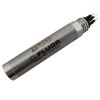Turner Designs DataBank Handheld Data Logger
Features
- Stores up to 9,999 records and 16 calibrations
- Simplifies sensor calibration & includes auto-gain function
- Now includes integrated GPS standard with the purchase
- Free ground shipping
- Expedited repair and warranty service
- Lifetime technical support
- More
Overview
The Turner Designs DataBank is a universal meter, data logger, & power supply. Data can be stored and downloaded to a PC. Sensor calibration is simplified through continuous sensor readings with results graphically displayed. Sensor power is provided directly from the DataBank, which is powered by internal rechargeable batteries, an external 9-30VDC power source, or AC power.
GPS Data
GPS data are integrated into the DataBank. Each line of data that is stored or exported contains time, date, and position information, as well as the sample measurement. The Turner Designs DataBank is ideal for conducting dye trace studies, mapping algal blooms or looking for the presence of optical brighteners as an indicator of wastewater contamination.
- (1) DataBank data logger with rechargeable NiMH batteries
- (1) PC/Power USB interface cable
- (1) AC to DC charger supply
- (1) USB Drive with Software
In The News
Stone Lab: Cyanobacteria Monitoring in Ohio Lakes
Microcystin, one of several toxins produced by the cyanobacteria that form harmful algal blooms (HABs), has become a popular topic of lake research as the human health impacts of HABs become better understood. Stone Lab is one of the leading groups in algal bloom research on Lake Erie and other lakes in Ohio. For more than 100 years, Stone Lab has conducted biology research and provided science education and outreach to the region. Over the years, thousands of individuals of varying ages have learned from the resources Stone Lab provides. Stone Lab’s Research Coordinator and Senior Researcher, Justin Chaffin, learned of Stone Lab while an undergraduate student at Bowling Green State University Fireland Campus.
Read MoreFrom Assessment to Angler: Continual Research Ensures Lake Erie Remains a Beacon of Freshwater Fishing
Lake Erie is well known for its abundant recreational fishing. Anglers come from across the country to try their luck at the “walleye capital of the world” and search for other freshwater species, such as bass, perch, and steelhead trout. As one of the world’s largest freshwater fisheries, much effort is made behind the scenes to maintain fishing opportunities for visitors to enjoy year after year, efforts that often go unnoticed by the public. One of the lake's most important economic and tourism centers is the city of Sandusky, home to the Sandusky Fisheries Research Station . As part of the Ohio Division of Wildlife, the unit serves as a base for assessing fish populations and managing harvest with partner agencies from around Lake Erie.
Read MoreHigh Definition Stream Surveys: Informed Management in Local Waterways
When it comes to environmental monitoring, new stream survey methodologies have revealed a great deal about water quality and streambed conditions over time. Such information can be particularly important in leading restoration initiatives and prioritizing management decisions. Historically, stream surveys have been conducted at a single point along the stream, with data then extrapolated for miles up and downstream. However, Brett Connell, Hydrologist and Director of Sales at Trutta Environmental Solutions, started developing a more intensive stream survey format in his master's program in 2010 at the University of Tennessee.
Read More





























